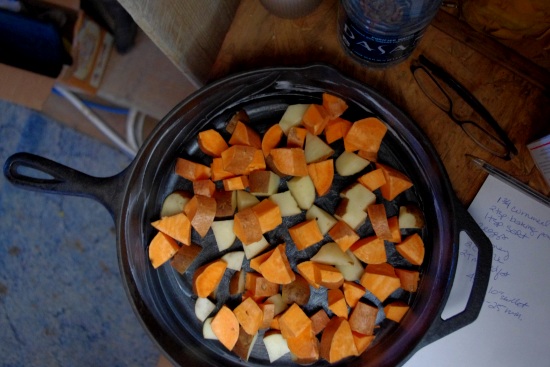Collecting and Using Cast-Iron Cookware

I’m sure it’s already a dead giveaway, but I’m a lover of all things old timey. I like the slow and simple life of those who lived before computers and electronic appliances and large-scale grocery stores.
So it’s no surprise, I’m sure, that I am enthusiastically collecting cast-iron cookware. Now, you might be thinking that by collecting them I mean that I am using them as a wall decoration to create the essence of old time kitchen lore in my own kitchen.
I’m afraid it’s not that glamorous. In fact, it’s only on a good day that most of my cast-iron pots, pans, and griddles aren’t dirtied from breakfast, lunch, or dinner – sometimes all at once.
I use a skillet in the morning to cook eggs. I use a skillet at lunch to fry vegetables. I use a skillet at dinner to roast meat and vegetables in one pan. I bake quick bread in skillets, yeast breads in Dutch ovens, and cook rice and potatoes in a 1/2 gallon cast-iron pot with convertible lid.
And the newest member of my collection is a griddle that weighs more than one of my children and can be flipped to use as a grill for things like burgers and pork chops.
Seasoning
I’d like to tell you that all of the pans are perfectly seasoned and lovely and nothing ever sticks to them, but that’s not reality… at least not my reality.
I season my cast-iron usually with lard or coconut oil. I wipe it around with a rag and place it on a cooling cook stove or into a low oven. And then I leave it there for hours.
One of the best ways to season a skillet, though, is through the frying of foods. I’m not talking a couple of tablespoons of fat, I’m talking measurements in at least the 1/2 cup range. This heating and cooking with high-heat-stable fats such as tallow, lard, and coconut oil really help keep the skillets smooth and shiny.

Washing
When food does stick, and it inevitably will unless you’re super duper about keeping your cast-iron perfectly seasoned, I use a stainless steel kitchen scrubber to scrub away any stuck on food residue and then I rinse it with warm water. You’ll notice I didn’t say soapy water. Soap removes grease and grease is what creates your pan’s seasoning. Therefore you do not want to use soapy water.
You can also just wipe the pan out with a rag or paper towel once all of the gunk is out. If you’re worried about bacteria remember that heating your pan up will kill anything that might “bug” you.
Storing
We have a pot rack above our sink area where I store small and large pots, none of which are cast-iron. I’m just kind of afraid that one of these days a pan will get knocked off and lay me flat out while I’m washing dishes.
So, instead, I usually throw the clean ones on top of our (non-burning) wood stove, next to it, or in or on top of an oven that is not on. Some sturdy hooks in a 2×4 might work as well.
What excites me about cast-iron isn’t just the fact that I can fry eggs without weird stuff like teflon, but that maybe someday my daughter or sons will be cooking with that same cookware, maybe even after I’m gone.
The stuff really is that sturdy.
So if you haven’t already started cooking with cast-iron then I would recommend finding a 10″ or 12″ skillet and going from there. I can’t imagine you’d regret it and you might even get really excited about scrambled eggs that, if cooked right, never really stick to the pan.
